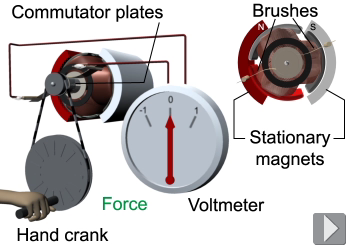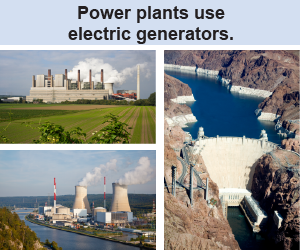|
Look back at the diagram of how the electric motor works on page 553. What happens if, instead of powering the motor with electricity, you now crank the axle of the motor by hand? What happens when you attach the leads to a voltmeter, rather than driving the device with voltage from a battery? 
|
 The result of hand cranking a motor is shown in the figure at right. As the coil on the armature passes the stationary magnets, electromagnetic induction causes a voltage to be induced in the wire. As a given coil approaches the north magnetic pole stationary magnet, the magnetic flux through the coil increases—which induces a negative voltage according to Faraday’s law. If the hand were to crank the generator in the opposite direction, the same coil would instead approach the south stationary magnet, causing magnetic flux through the coil to decrease and inducing a positive voltage. The electric motor has become an electrical generator!
The result of hand cranking a motor is shown in the figure at right. As the coil on the armature passes the stationary magnets, electromagnetic induction causes a voltage to be induced in the wire. As a given coil approaches the north magnetic pole stationary magnet, the magnetic flux through the coil increases—which induces a negative voltage according to Faraday’s law. If the hand were to crank the generator in the opposite direction, the same coil would instead approach the south stationary magnet, causing magnetic flux through the coil to decrease and inducing a positive voltage. The electric motor has become an electrical generator! 
|
 The heart of the generator consists of a wire coil that is rotating in a magnetic field, as shown in the figure at left. As the coil rotates, the magnetic flux through the plane of the coil changes, which induces an electric current in the coil. The magnetic flux increases and decreases as the coil rotates, causing a negative and positive induced voltage, respectively.
The heart of the generator consists of a wire coil that is rotating in a magnetic field, as shown in the figure at left. As the coil rotates, the magnetic flux through the plane of the coil changes, which induces an electric current in the coil. The magnetic flux increases and decreases as the coil rotates, causing a negative and positive induced voltage, respectively. 
|
Many laws of physics display symmetry. The science of electromagnetism shows us a symmetry between electricity and magnetism. The flow of electric current creates a magnetic field, and a changing magnetic field results in the flow of electric current. An electric motor uses electricity to generate mechanical energy; an electric generator uses mechanical energy to generate electricity. The motor and generator have the same basic physics behind them, except that one uses the reverse process of the other! 
|
 The generation of electricity by wind generators, hydroelectric dams, nuclear plants, the engine in a car, or gas- and coal-fired plants is accomplished with electrical generators. Power plants have rotating machines called turbines that generate the rotational motion and power the electrical generator. Generators create alternating current, which is the kind of electricity used by houses and businesses. Most of the electricity you use every day was created by an electric generator.
The generation of electricity by wind generators, hydroelectric dams, nuclear plants, the engine in a car, or gas- and coal-fired plants is accomplished with electrical generators. Power plants have rotating machines called turbines that generate the rotational motion and power the electrical generator. Generators create alternating current, which is the kind of electricity used by houses and businesses. Most of the electricity you use every day was created by an electric generator. 
|
How are motors and generators alike?
 |
Both motors and generators deal with the conversion between mechanical and electrical energy, although motors convert from electrical to mechanical energy and generators convert from mechanical to electrical energy. Both have a rotating armature. Both have stationary magnets and rotating magnets. Both exploit the connection between electricity and magnetism—although the processes are reversed! 
|

